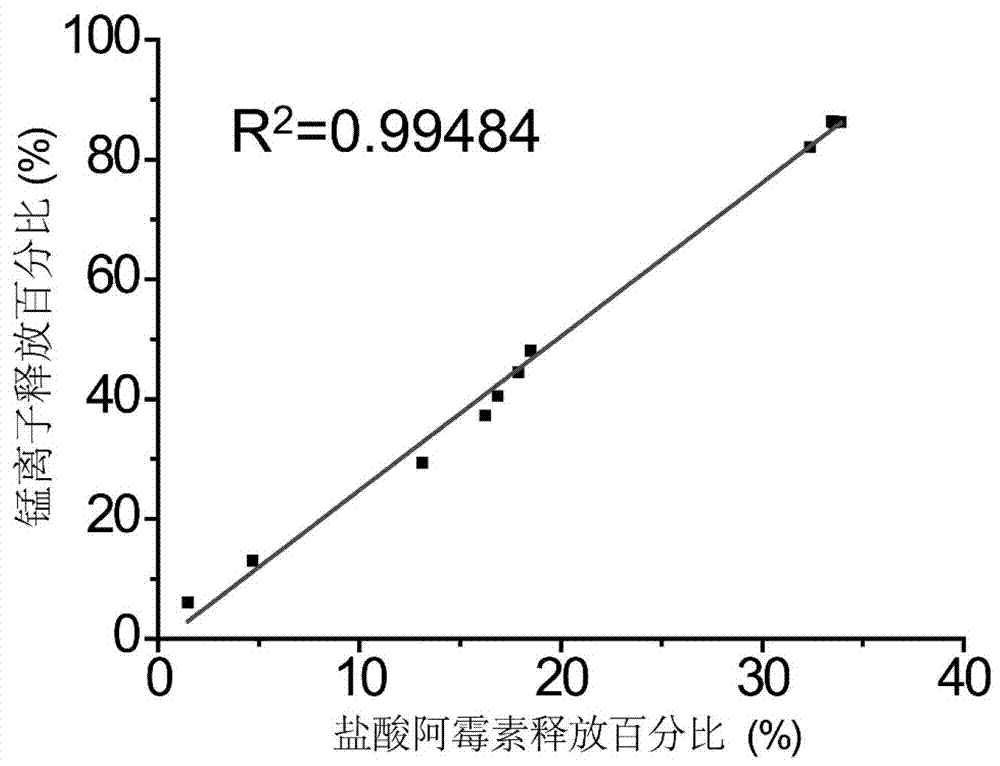Prussian blue-based smart pH-triggered MRI-monitored drug release synergistic nano-therapeutic agent and its preparation method
A Prussian blue and nanotechnology, applied in the field of nanomaterials and biomedical materials, to achieve the effect of excellent light-to-heat conversion performance
- Summary
- Abstract
- Description
- Claims
- Application Information
AI Technical Summary
Problems solved by technology
Method used
Image
Examples
preparation example Construction
[0052] figure 1 A schematic diagram showing an exemplary preparation method of the present invention. The preparation method of the nano-diagnostic agent of the present invention comprises: using potassium ferricyanide as a raw material to prepare a hollow mesoporous Prussian blue nanocube (HMPB) template, and preparing a hollow mesoporous nanoparticle (HMPB-Mn) based on Prussian blue with a core-shell. However, the method for preparing HMPB is not limited, and various known methods can be used. In one example, the preparation method of HMPB can comprise the following steps:
[0053] A) According to the mass ratio, add 0.132-0.396 parts of potassium ferricyanide and 2-10 parts of polyvinylpyrrolidone into 30-100 parts of acid (such as 0.01-2M hydrochloric acid), mix and stir evenly, and age at 60-100 °C After cooling, separate and wash to obtain Prussian blue nanoparticles with mesoporous pores;
[0054] B) Disperse the obtained mesoporous Prussian blue nanoparticles in 50-...
Embodiment 1
[0080] Weigh 132mg of iron (III) potassium cyanide and 3g of polyvinylpyrrolidone K~30 (PVP) in 40mL of 0.01M hydrochloric acid, stir for 30min to fully dissolve to form a yellow transparent solution, and place it in an oven at 80°C for 20h. Centrifuge at 11000r / min for 10min and wash once with water to obtain mesoporous Prussian blue nanoparticles (MPB). MPB was dissolved in 20mL of 1M hydrochloric acid to disperse evenly, hydrothermally etched at 140°C for 4h, centrifuged at 11000r / min for 10min, washed once with water to obtain hollow mesoporous Prussian blue (HMPB) and dried for later use;
[0081] After etching with 1M hydrochloric acid, a hollow structure is formed, the particle size remains basically unchanged, the dispersion is good, and the shell wall thickness of the hollow structure is 10-100nm;
[0082] Next, 4.4 mg of manganese acetate, 11.4 mg of sodium citrate, 500 mg of PVP, 10 mg of HMPB and water were magnetically stirred to obtain a clear solution. Dissolve...
Embodiment 2
[0085] The HMPB-Mn obtained in Example 1 is dispersed in PBS, and its absorption peak at the near-infrared light is measured with a UV-Vis spectrophotometer, as shown in Figure 4 As shown (wherein HMPB-Mn 11 means that the molar ratio of iron and manganese is 11:1, and HMPB-Mn 5.5 means that the molar ratio of iron and manganese is 5.5:1), it can be seen that the prepared material has a relatively high performance in the near-infrared region. Strong and broad absorption peak, the strongest around 720nm.
PUM
| Property | Measurement | Unit |
|---|---|---|
| particle diameter | aaaaa | aaaaa |
| thickness | aaaaa | aaaaa |
| thickness | aaaaa | aaaaa |
Abstract
Description
Claims
Application Information
 Login to View More
Login to View More - R&D
- Intellectual Property
- Life Sciences
- Materials
- Tech Scout
- Unparalleled Data Quality
- Higher Quality Content
- 60% Fewer Hallucinations
Browse by: Latest US Patents, China's latest patents, Technical Efficacy Thesaurus, Application Domain, Technology Topic, Popular Technical Reports.
© 2025 PatSnap. All rights reserved.Legal|Privacy policy|Modern Slavery Act Transparency Statement|Sitemap|About US| Contact US: help@patsnap.com



